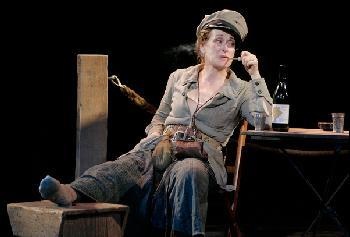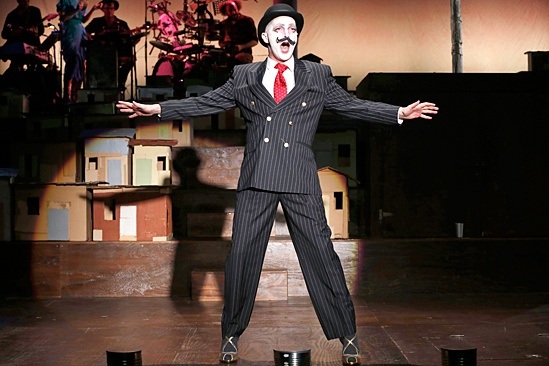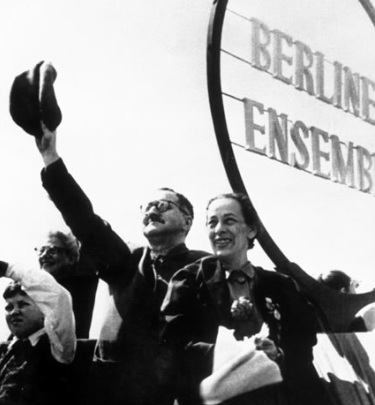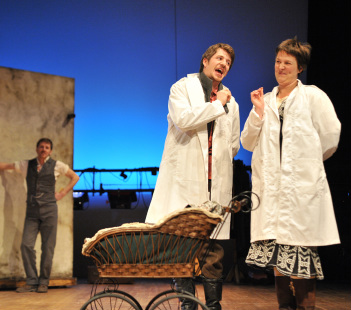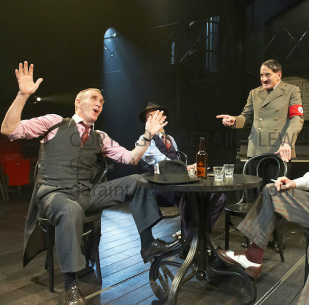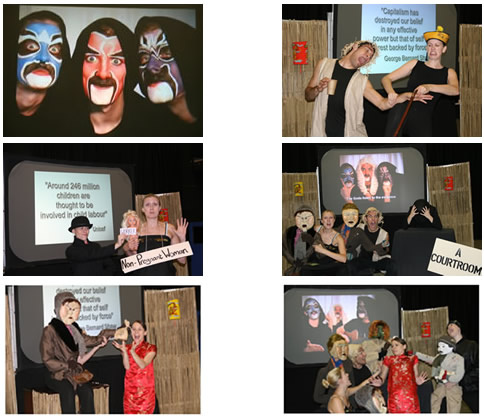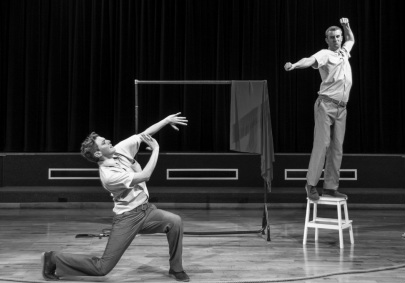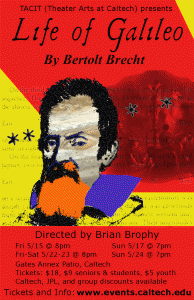Aims- Verfremdungseffekt (Alienation effect), episodic plays with politic messages, affect change, make the audience question, satirise political situations
Key Features of his Practice
|
Gestus
A mix between Gesture and attitude- how you physically embody a character and what it says about them/ their motives. Here Meryl Streep as Mother Courage in Mother Courage and Her Children portrays Courage's 'Gestus' - She is not a very Motherly character, so sits in a masculine fashion smoking a Pipe |
|
Narration (direct address)
Brecht does this in a range of ways- there may be a character that is there to simply act as a narrator, characters sometimes directly speak the the audience in asides or come out of character entirely to comment on who they are playing Here, Shen Te in The Good Person of Szechuan discusses with the audience the nature of having to pretend to be a man in order to get her own way. |
|
Ensemble (multi-role playing)
Brecht believed no one actor should be a star- so the play should be presented by an ensemble of actors (he even named his theatre 'Berliner Ensemble') Brecht would have actors 'represent' may characters and often change character in front of the audience (thus Alienating them, as they will not emotionally attach to them) Characters are shown using- Gestus, Representational costume and gestus. Sometimes he would use the notion of a 'play within a play' where actor would play a character that portrays further characters to tell the story. |
|
Representational Props/ costume
A single piece of costume or a prop that are used to represent an entire character or set Here two actors in Caucasian Chalk Circle wear doctors white coats to play 'Doctor 1' and 'Doctor 2', but still wear underneath their other costumes. This helps to remind the audience they are still actors simply representing a character. This also allows for fast changes in an ensemble, meaning an actor can instantly represent a new character by simply putting on a hat. |
|
Spass
This word means 'fun' in German. Brecht's early plays were a bit dull as they only focused on their political message. This put off audiences, so Brecht decided to make his plays more satirical and comic so that the audiences would be drawn in by the fun. For example in this picture from The Resistible Rise of Arturo Ui the audience are led to believe they are watching a comic play about a hapless gangster, only to slowly realise the play is about how Hitler managed to take control by appearing harmless. The effect of this is that the audience want to pay attention as they are enjoying themselves and then the contrast when something serious happens has a great impact and that makes the audience shocked by it- emphasising the message. |
|
Placards
Placards are used to give clear messages to the audience- they may be held by an actor or projected. In the example here, from The Good Soul of Szechuan Plac ards are used to both push a political message: 'around 268 million children are thought to be in child labour', to show location: 'A Courtroom' and as a representational prop 'Non-Pregnant Woman' |
|
Tableaux
Essentially a Tableaux is a 'freeze frame', but it is held at a significant moment, either to highlight a message on a placard or to clearly draw attention to character's Gestus. This is held for a couple of seconds to 'mark the moment' Such as this example from Antigone, where the actors are showing Creon (on the stool) is making Antigone (on one knee) the victim, as their Geste are perfectly matching, with him looking aggressive and her defensive- making the intentions/ attitudes of the characters explicitly clear to the audience |
|
|
Dischordant music
On a technical level, music is discordant because there is a sense of dissonance where notes do not harmonise. However, with Brecht he would also use this where the atmospheric tone of the song did not match the tone of the scene, making it more effective for instance, in this video of the film version of Brecht's play The Threepenny Opera Roger Daltry sings an upbeat song called 'Mac The Knife', cheerfully grabbing children onto his cart and smiling with them; but actually the song is about a man named Macheath, who within the song murders atleast 4 people and assaults several women. |
|
Historification
By setting his plays in different countries and time periods, Brecht was able to allagorically make comments about issues in the present. As he had set it in a different time period, the audience were not immediately aware of what the social comment was- meaning he could draw them in before tryign to make them question their opinions. For instance, his play The Life of Galileo appears to be about the 16th/17th century scientist Galileo- but Brecht is in fact commenting on modern attitudes to Marxism (Galileo's science is rejected as being wrong, but in time is found to be entirely correct- changing the world, Brecht is inferring that Marxism is the same.) |
Videos
|
|
|
